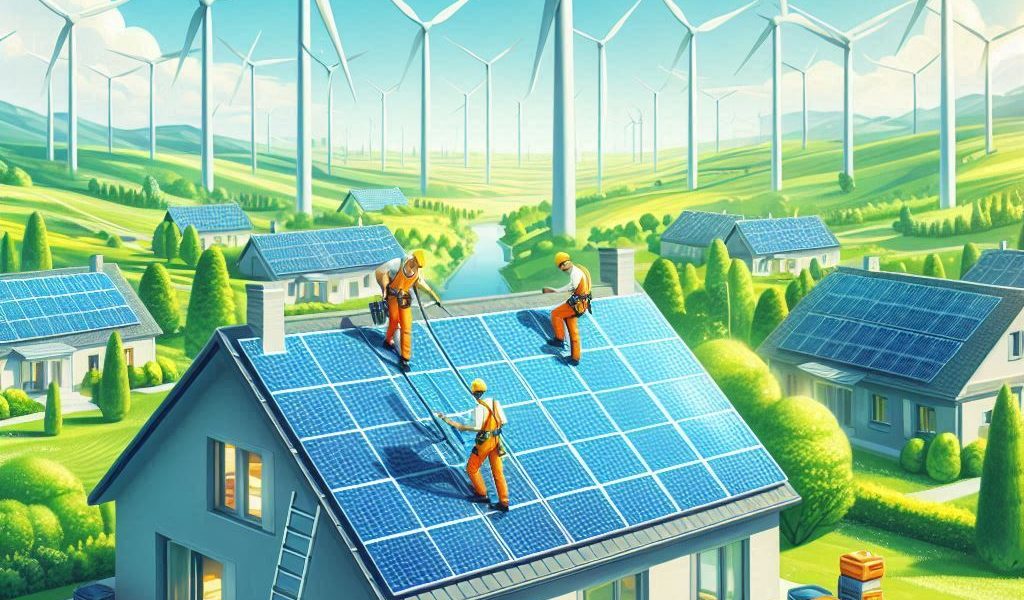As the world turns its focus to sustainable energy solutions, renewable energy sources such as solar and wind power have become pivotal in the fight against climate change. To accelerate the transition to renewable energy, governments worldwide have introduced a variety of subsidies and incentives aimed at reducing the financial burden of adopting solar and wind energy systems. These government programs help individuals, businesses, and organizations make the shift to cleaner energy sources, ultimately contributing to environmental conservation and economic growth.
In this comprehensive guide, we’ll explore the government subsidies and incentives available for solar and wind power in India. We’ll also examine the steps for accessing these benefits, the eligibility criteria, and the types of financial assistance you can avail yourself of to make renewable energy solutions more affordable.
Why Do We Need Government Subsidies for Renewable Energy?
Renewable energy technologies, such as solar panels and wind turbines, require significant initial investment. While the long-term savings and environmental benefits make renewable energy systems a wise choice, many individuals and businesses are unable to afford the high upfront costs. Government subsidies and incentives bridge this gap by providing financial support for those looking to invest in solar or wind energy systems.
Some of the key reasons why renewable energy subsidies are essential include:
- Encouraging the Adoption of Clean Energy: Government incentives reduce the cost of installation, making it easier for individuals and businesses to make the switch to solar or wind power.
- Reducing the Dependence on Fossil Fuels: By promoting solar and wind energy, subsidies help reduce reliance on fossil fuels, which are finite and contribute to environmental pollution.
- Fighting Climate Change: Solar and wind energy generation produces little to no greenhouse gas emissions, making them crucial in the fight against climate change.
- Supporting Economic Growth: Investments in renewable energy can create job opportunities in the clean energy sector, further contributing to economic growth.
Government Subsidies and Incentives for Solar Power
India has been a global leader in pushing for solar energy adoption. The government has introduced several schemes to help individuals, businesses, and industries access solar power at an affordable cost.
1. Pradhan Mantri Kisan Urja Suraksha evam Utthaan Mahabhiyan (PM-KUSUM)
PM-KUSUM is a government initiative aimed at promoting the adoption of solar energy among farmers, rural households, and industries. The scheme focuses on installing solar power pumps, rooftop solar systems, and grid-connected solar projects.
- Eligibility: Farmers, rural residents, and businesses with a need for irrigation or electricity are eligible for this scheme.
- Subsidy Amount: The scheme offers subsidies of up to 60% of the cost of solar power pumps, 30% for setting up rooftop solar systems, and 30% for grid-connected solar projects.
- How to Apply: Applicants can apply through the Ministry of New and Renewable Energy (MNRE) portal, which provides guidelines and instructions for availing of the subsidy.
2. Solar Rooftop Scheme (MNRE)
The Ministry of New and Renewable Energy (MNRE) launched the Solar Rooftop Scheme to encourage residential, commercial, and industrial properties to install rooftop solar panels. This initiative provides financial assistance to make solar rooftop systems affordable.
- Eligibility: Homeowners, businesses, and industries can apply for this subsidy. Priority is given to those with larger energy consumption requirements.
- Subsidy Amount: The MNRE offers a subsidy of up to 40% for residential installations, 20% for commercial and institutional installations, and 10% for industrial establishments.
- How to Apply: To apply, visit the official MNRE website, where you can find a list of empanelled vendors and guidelines for installing solar rooftop systems.
3. State-Level Solar Subsidies
In addition to national-level schemes, many states in India have launched their own solar power subsidies and incentives. These state-level programs aim to promote solar energy adoption in regions with high potential for solar power generation.
Some states with notable solar subsidies include:
- Maharashtra: The Maharashtra government offers financial incentives for residential, commercial, and industrial solar rooftop installations. Subsidies can be up to 50% of the total cost for smaller installations.
- Gujarat: Gujarat provides incentives for setting up rooftop solar systems under the “Gujarat Solar Power Policy.”
- Tamil Nadu: The Tamil Nadu Energy Development Agency (TEDA) offers subsidies for solar power projects and also provides support for solar water heating systems.
Each state has its own criteria and application processes, so it’s important to check with the local authorities to understand the specific requirements.
4. Subsidy for Solar Water Heating Systems
In addition to solar power generation, India also offers subsidies for solar water heating systems, which are a cost-effective and eco-friendly way to supply hot water in households, hotels, hospitals, and industries.
- Eligibility: Any residential or commercial establishment can apply for this subsidy.
- Subsidy Amount: The subsidy varies from state to state, but generally, up to 30% of the installation cost is covered.
- How to Apply: Applications can be made through the MNRE website or local solar heating system providers.
Government Subsidies and Incentives for Wind Power
Wind energy has emerged as a reliable and sustainable energy source, particularly in regions with high wind potential. The Indian government has recognized the importance of wind energy and offers various subsidies and incentives for individuals and companies to invest in wind energy projects.
1. National Wind-Solar Hybrid Policy
This policy aims to promote hybrid renewable energy projects by integrating wind and solar power generation systems. The government encourages the development of large-scale hybrid wind-solar plants, especially in regions with significant wind and solar resources.
- Eligibility: Developers and companies involved in setting up hybrid renewable energy projects are eligible for this scheme.
- Subsidy Amount: The government provides a capital subsidy for setting up hybrid plants, in addition to offering incentives for setting up wind power projects.
- How to Apply: Interested applicants can apply through the Ministry of New and Renewable Energy (MNRE) and the respective state government agencies.
2. Wind Energy Projects: Accelerated Depreciation
The Indian government offers incentives such as accelerated depreciation (AD) for individuals and businesses that invest in wind power projects. AD allows investors to claim depreciation benefits on wind energy equipment and infrastructure, which can offset some of the initial costs.
- Eligibility: Companies and individuals who invest in wind energy projects are eligible to claim AD benefits.
- How to Apply: The application for accelerated depreciation is processed through the Income Tax Department, and it allows investors to claim tax benefits for their wind power investments.
3. State-Specific Wind Energy Incentives
Similar to solar power, many Indian states have introduced specific subsidies and incentives to promote wind energy. States like Tamil Nadu, Gujarat, Maharashtra, and Rajasthan offer financial assistance to wind power developers and investors.
For instance, Tamil Nadu provides a feed-in tariff (FiT) for wind energy projects, allowing project developers to sell power at favorable rates to the state electricity grid.
4. Wind Power Generation: Power Purchase Agreements (PPAs)
Power purchase agreements (PPAs) are contracts between wind power producers and state electricity boards or private companies for the sale of generated power. These agreements often include favorable rates and subsidies to incentivize the growth of wind power.
How to Apply for Renewable Energy Subsidies
The process to apply for renewable energy subsidies varies depending on the type of subsidy, the renewable energy technology, and the location. However, the general steps involved are as follows:
- Determine Eligibility: Check if you meet the eligibility criteria for the chosen subsidy scheme. This can include income criteria, location, energy requirements, and property ownership.
- Gather Necessary Documents: Documentation required may include proof of identity, income details, proof of property ownership, and technical specifications of the renewable energy system.
- Apply Online or Offline: Most government schemes allow online applications through official portals such as MNRE or state government websites. Alternatively, you can apply directly at banks or financial institutions associated with the schemes.
- Site Survey and Installation: After your application is processed, a site survey may be conducted to assess the feasibility of the renewable energy system. Once approved, the installation will begin.
- Subsidy Disbursement: After the installation of the system, the subsidy amount will be credited to your bank account or provided as a discount on the total cost.
Conclusion
With the Indian government’s continued commitment to clean energy, there are numerous subsidies and incentives available to help individuals, businesses, and industries make the switch to renewable energy. Solar and wind power not only contribute to a cleaner, greener environment but also offer long-term economic and energy savings. By utilizing government subsidies, you can make the transition to renewable energy more affordable, while simultaneously contributing to a sustainable future.
Whether you are looking to install a solar rooftop system or invest in a wind energy project, the government incentives available can help reduce the financial burden and encourage you to adopt sustainable energy solutions. Stay informed, check eligibility criteria, and apply for the subsidies that best suit your needs to make the most of the renewable energy revolution.



